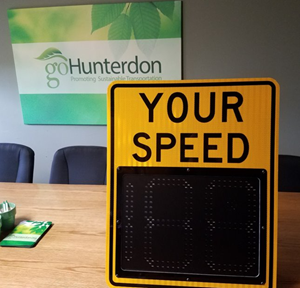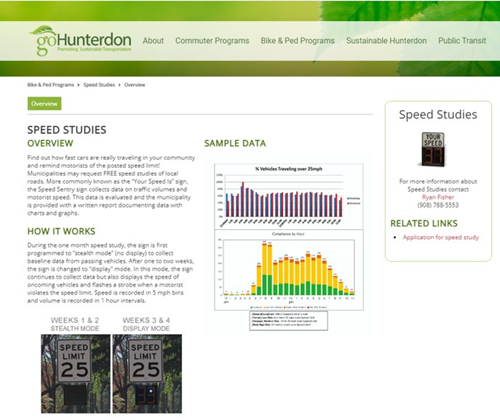If you’ve ever driven past an electronic sign that doesn’t always flash your speed in miles per hour (mph), don’t assume that it’s not collecting your data.
goHunterdon, the Transportation Management Association (TMA) for Hunterdon County, partners with municipalities that request to use its speed monitoring program and studies locations for a month – the first two weeks operate in “stealth” mode, followed by two weeks in “display” mode.

“It’s funny because we always talk about how many residents or people from town tell us that the sign isn’t working, it’s off. That’s what we’re looking for, we’re looking for stealth data,” Ryan Fisher, goHunterdon’s safety programs manager, said. Fisher and Executive Director Tara Shepherd briefed members of The NJTPA’s Regional Transportation Advisory Committee (RTAC) about the speed monitoring program during their October 12 meeting.
“Vehicle speed is one of the most important factors in crash severity,” Peter Bilton, Principal Planner, TMA & Mobility Programs, at NJTPA, said. “The risk of serious injury and death increases with increase in vehicle speeds and that’s why safe speeds is one of the five components of the Federal Highway Administration’s Safe Systems approach.”
In 2020, speeding deaths represented 29 percent of all traffic fatalities, up from 26 percent in 2019, according to the National Highway Traffic Safety Administration (NHTSA).
goHunterdon started its speed monitoring program about 10 years ago as a loan program, in which municipalities could borrow a radar unit. It has since evolved into a more formalized program, with 73 studies conducted for municipalities, many of which asked for multiple studies, according to Shepherd.
Flemington-based goHunterdon is among four TMAs with speed study units. The others (
Avenues in Motion,
Greater Mercer TMA, and
Ridewise) typically use their speed study programs to evaluate the effectiveness of the messaging of the
StreetSmart NJ campaign, Shepherd said, adding that goHunterdon is the only TMA providing
speed studies for municipalities.
.png.aspx?width=135&height=100)
goHunterdon’s program was started based on feedback from partner municipalities that would get resident complaints or concerns about speeding on local roads. The program allows municipalities to collect objective data but also prioritize enforcement locations and times, Shepherd said. The signs, when displaying speeds, can also assist municipalities interested in a traffic-calming mechanism.
An online application for the program typically is completed by someone from the police department or the clerk or mayor. Once the municipality installs a metal post at the preferred location, goHunterdon will install one of two available signs, one an 11-inch display and the other 12 inches. The 20-pound unit runs $3,000 to $4,000 and includes a one-year cloud data subscription that costs $400 annually after the first year, Shepherd said. goHunterdon received a grant from the New Jersey Division of Highway Traffic Safety to purchase the units and software.

Studies run for one month – the first two weeks in stealth mode, followed by two weeks in display mode. In stealth mode, the unit appears off but collects data and in display mode it will flash and show vehicle speeds. goHunterdon then generates a report that examines average speed and 85th percentile speed. “There isn’t always a problem,” Fisher said, citing an example of a study of a 25 mph zone that showed average speed of 15 mph and 85th percentile speed of 22 mph.
“Residents might feel that cars are speeding but this alleviates concerns from some residents,” Fisher said. When there is speeding, the data could suggest what time a patrol car should be in that location. The units also are used for vehicle counts, which can be helpful to local police when examining construction projects to see how a road is affected by traffic volume.
“Most of the communities that we were work with are looking at this in a comprehensive way and this is just another data point that they use in those conversations. We have provided speed study information to consultants that have prepared applications for different infrastructure funds,” Shepherd said. “We’ve done a lot of studies around schools and developing school traveling plans, things like that. Each municipality’s a little different how they use it but they’re all very appreciative of it.”